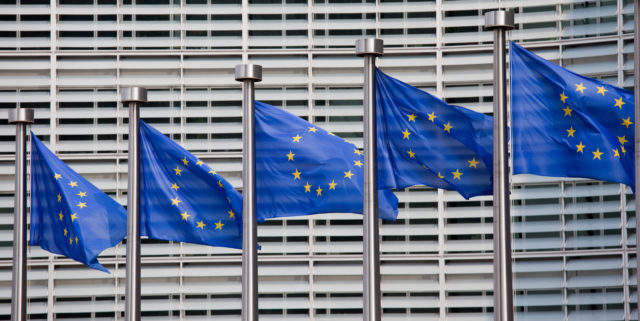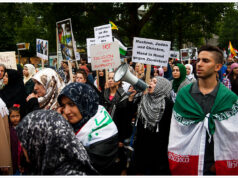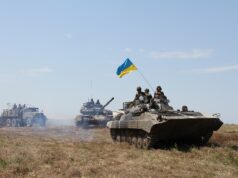On August 3, 1914, the eve of British entry into World War I, Foreign Secretary Sir Edward Grey told a friend that “[t]he lamps are going out all over Europe; we shall not see them lit again in our life-time.”
I begin this reflection on the European Union with this famous observation because it encapsulates the whole point of the European project launched in the wake of World War II. Grey went on to note “that a great European war would be a catastrophe on an unprecedented scale, and that this would be so obvious to all the Great Powers that, when on the edge of the abyss, they would call a halt and recoil from it.”
They obviously did not do so. Crowds in Europe’s capitals reacted with enthusiasm to the outbreak of World War II as if they anticipated catharsis from . . . intracteable, endless, social and political conflict? Boredom? In the late 1940s, the leaders of Europe’s greatest powers, although those states were much diminished by the destruction of 1939-45, understood what their predecessors had failed to grasp: the need to do Europe’s business in a different way and within different structures if they were to escape the historical ruts of European geo-politics.
The British Brexit debate and the messages carried to Europe by people who have the President’s ear missed the foregoing premise for what became the European Union (EU). As a result, it seems easy to fans of Brexit and their confrères in Italy, Hungary, and elsewhere to dismiss the project as a product of elites without regard to ordinary people. From this perspective, elites formed European-wide organs out of touch with the people who give them legitimacy. Whatever their merits, criticisms of European institutions on the ground that they often appear to be duplicative or operating mainly or even sometimes solely for the benefit of themselves, miss the point. What government and what politician, however democratically elected, has not appeared to lose touch, or really has lost touch, with constituents? What bureaucracy has not, consistent with one of Parkinson’s Laws, operated without regard to the outer world? These political and bureaucratic tendencies do not undermine the legitimacy of elections or the democratic source of government offices. Those participating in the debate in 2016 failed to remind the British electorate that the European Community and now the EU restructured Europe’s security and proved to be an integral part of the longest period of peace among European great powers in history. The same period also has known the largest number of democratic, European states.
America’s Role
Absent in 2016 were strong messages from America’s leadership about the U.S. vital national security interest in European peace and prosperity. All U.S. Cold War Presidents—Truman, Eisenhower, Kennedy, Johnson, Nixon, Ford, Carter, Reagan, and Bush 41—understood and accepted that the European project strengthened world peace and American security. Their administrations were deeply engaged with their European counterparts in fostering European integration after World War II. European economic and potentially political cohesion formed an integral part of the Marshall Plan idea. Integration rooted in democratic process and the rule of law seemed a logical response to Europe’s wars, which had shaped world history for centuries. U.S. engagement took different forms, including efforts by private American citizens to help Europeans think through and resolve problems associated with trying to create a new European order. In view of how much has been forgotten, a modest refresher on the EU’s object, purpose, and structure seems to be appropriate.
European History
To understand the whys and wherefores of what became the EU requires some understanding of European history and culture. First, among other things, Europe’s history has been a history of violence. Conflict has characterized every century since the fall of the Roman Empire, and each European-wide war has involved more devastation than the last. Since the middle of the eighteenth century, wars among Europe’s great powers have been world wars, fought between Europeans everywhere Europeans found themselves. And, since the Napoleonic Wars spawned the Concert of Europe, the increasing destructiveness of war, especially the charnel houses of 1914-18 and 1939-45, propelled the search for alternative ways of structuring and conducting international relations: governments and invisible principles such as the balance of power had failed to maintain peace. The European project, beginning with the European Communities and continuing in the European Union, reflected the belief that European peace was essential, not only to Europeans, but also to people everywhere, and that new methods for securing that peace were necessary.
Economic Union
Second, the founders of what became the European Union thought economic union was a way to break with the violence of the recent past and the cycles of European-wide wars that had punctuated the previous five centuries. The framers of European integration believed in democracy and that their Europe should reflect democracy. They were intensely practical men who had wide experience in intergovernmental work. While some favored a new creation, “the United States of Europe,” others preferred inter-governmental integration by means of a voluntary association of states. The intergovernmental idea prevailed, but there never has been consensus about the final product: a new country? A stand-alone common market with few supranational attributes? A common market with a single currency and therefore a single approach to fiscal and monetary policy? A pluralistic polity with central and poly-centric aspects? The obvious complexity of Europe—consisting of ancient, sovereign states, with different capacities in terms of power and power projection, and different political and legal cultures, but most having strong senses of nationalism and awareness of long histories of conflicts with neighbors—meant that no single conception of the new post-World War II Euorpean structure was going to take hold, at least in the near-term.
Treaties among democratic states would form Europe’s institutions. If those states so agreed, organically democratic, European-wide institutions subsequently could develop. Such institutions and the transnational effort their existence and operation reflected would keep the peace and enhance prosperity. The founders of post-World War II Europe were successful.
Third, from the outset, the purpose of European integration was strategic and political. The object was to address the problem created by German unification in 1871. After 1871, Germany was the most powerful European state, and it was restless. It remains the most powerful but no longer is restless. The idea in the minds of such originators of contemporary Europe as Jean Monnet and Robert Schumann was to enmesh a democratic Germany in a larger democratic whole. The European Coal and Steel Community of 1952 and the European Economic Community and the European Atomic Energy Community, 1957, reflected that requirement. They proved to be steps along the way to treaties ultimately establishing the European Union and the common currency, the Euro.
EU history has involved zig-zags. The first zag was the defeat of the idea of pan-European defense—the European Defense Community, which went down in 1954, the year of Dien Bien Phu. It was too soon after World War II for France, which had originated the idea, to accept German rearmament, even within a larger whole. Another zag was the defeat meted out to the European constitution by voters in France and the Netherlands in 2005. The next zig was the Lisbon Treaty in 2007, which repackaged much of the rejected constitution in amendments to the 1957 Treaty of Rome—the foundational document of the European Community. Another zag is Brexitism. Is it a yearning for something more fulfilling than European peace and prosperity? Is it a product of excessive optimism about the EU’s ability easily and without stress to integrate new members after the dissolution of the Warsaw Pact?
European Institutions
The EU of today consists of variegated institutions, formed at different times for different purposes, often a jumble with overlapping jurisdiction, and established as part of the layering process that has built the union. EU institutions represent different forms of democratic legitimacy: some are intergovernmental, such as the European Council of heads of state or government and the Council of the European Union, which consists of heads of member state government departments. The European Commission is an unelected group of senior officials and policymakers appointed by member states but independent of such member states in their exercise of treaty functions. The European Commission is as close to being an executive as the EU has. The European Parliament is directly elected. Member states appoint judges on the European Court of Justice; all member states concur in the appointment. This list of institutions is intentionally incomplete. The number, complexity, and staffing of EU institutions perhaps fuel resentment among Europe’s citizens who have enough trouble living their lives without layer upon layer of government telling them what to do and how to do it.
A substantial number of Europeans experience the EU with indifference, confusion, and resentment. One therefore frequently reads about unelected officials in Brussels and a European Parliament without power to initiate legislation. Perhaps even more damning, Europeans exhibit insufficient concern about what goes on at the level of Europe: participation in European-wide elections is far below participation rates for national elections. Skeptics or cynics are wont to quote Ortegaky Gasset from 1930 that “‘Europe’ was for practical purposes ‘the trinity of France, England, and Germany.”’ Each of the three has its own take on the EU. The British remain formally committed to a European balance of power. But, if British understanding of the reality were deeper than it appears to be, Brexit would cease to be an option. For Germany, the EU represents the brightest of futures and the strongest protection against, and break with, the past. For France, the EU is where De Gaulle’s certain idea of France can retain vitality. Other members also pursue their interests and advance their identity in the EU context.
All European institutions operate directly by the consent of the governed or indirectly by such consent as a result of inter-governmental councils consisting of representatives of democratically elected governments. It is impossible to overemphasize this point although commentators of all stripes frequently fail to emphasize it adequately. Such pundits and others are convinced that there is some undemocractic conspiracy afoot, mainly involving unelected civil servants and bureaucrats with their own agendas at odds with those of elected officials. At the same time, the EU is not yet a government of the United States of Europe. Great and small European powers pursue their national interests within it. For this reason, if for no other perhaps, the large number of European institutions seem to be more responsive to those interests than to “the people.” That is not a reason to destroy the EU or to leave it. For Europeans, and for everyone else, what is the alternative to working within it, to improving it, to increasing its visible democratic legitimacy? Turning the historical page backward . . . to what? Old, blood-soaked historical patterns?
It is fitting to end this reminder about the EU’s central purpose by stating categorically that the European lamps are on if not necessarily ablaze in all respects. We need to remember that the European Union and the United States have roughly equivalent gross domestic products (GDP) although with its larger population the EU has a lower GDP per capita. However measured, the European Union constitutes an enormously powerful agglomeration that has yet to achieve full capacity to exercise that power. Jean Monnet envisaged the EU as one end of a trans-Atlantic barbell with the United States at the other end. Together they could ensure minimum world order. Some of his American interlocutors wanted a tighter, organic connection. Neither has quite become the reality. Despite political fissures, social dyspepsia, and “populism,” the ties that bind Europe and America ought to prove stronger than the centrifugal forces. The peace of the world and democracy depend on that proposition proving true.
Nicholas Rostow, Ph.D., J.D., is senior research scholar at Yale University.






